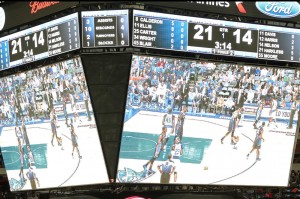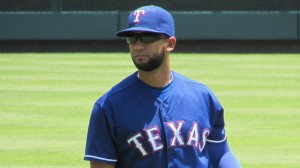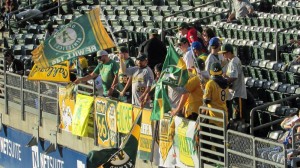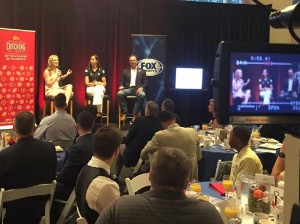This post originally appeared at the Fort Worth Weekly's website. To view it there : http://www.fwweekly.com/2016/06/28/sports-rush-mavs-gotta-do-what-exactly/
The Dallas Mavericks head into the free agency
season coming off a playoff season. They played a gutty series against
an exceptionally talented Oklahoma City team while shorthanded. For some
rosters, that might lead an optimistic Mavs fan to reason that the club
is one of those
“just-need-to-get-a-little-healthier-and-a-little-better-and-maybe-we-can-take-that-next-step”
teams.
Unfortunately, the squad that persevered well enough to earn a
postseason berth doesn’t seem to be a
“young-team-on-the-verge-of-breaking-out” or a
“veteran-team-that-can-make-a-title-run-by-shoring-up-a-key-position-in-free-agency.”
The concern seems to be that they are a
“middling-older-team-destined-for-upper-lottery-or-first-round-exit-for-eternity”
sort of squad.
The franchise’s main goal, one would assume with Mark Cuban in
charge, is to win another championship. Is there a path forward that
leads to having a realistic chance of achieving such? Let’s look at some
of the formulae that have worked for recent past champions.
1. Be-Led-By-A-Hometown-Superstar-Drafted-In-A-Premium-Position
For the past 60-some years, even extending back to the days of
territorial picks, only nine teams have managed to win a title without a
player they drafted among the top five overall picks, usually in the
top two or three. Five of those titles went to the Kobe/Shaq/Pau Lakers.
In basketball, a sport with only 10 players on the court at a given
time, a transcendent Magic Johnson, Tim Duncan, or Hakeem Olajuwon can
move the needle a lot. Free agency rules, including Bird rights, help
teams keep a player like that around, which, in turn, attracts other
good players.
The problem with this method is that you generally have to be really
bad, get lucky in the draft lottery, and then hope a no-brainer
superstar heads the draft that year instead of a Kwame Brown or Kent
Benson. To even have a chance to make this method work, you need to have
an unexpectedly injury-filled season, like the one the 1996-97 Spurs
had to get Duncan, or just tear everything down, like the 2010-11
Cavaliers were forced to do to get Kyrie Irving. Both options are yucky.
The Showtime Lakers landed Magic and James Worthy through free agent
compensation and a trade with Cleveland, respectively, but compensation
no longer exists and the Cavs’ picks aren’t worth much these days.
2. Hit-On-Lower-Draft-Picks
The good news is that seven of the nine champions who didn’t have
method one at their disposals have come this century. You could almost
throw the 2003-04 Pistons into that group (Darko Miličić – 2003 2nd
overall – didn’t contribute a lot) and the 2010-11 Mavericks (former 2nd
overall pick Jason Kidd left and came back) into the group. In fact,
inspired scouting led the Mavs to effectively nab Dirk Nowitzki 9th
overall (thanks to a draft-day trade with the Bucks) in 1998 and the
Celtics to take title centerpiece Paul Pierce with the next pick. The
Clippers had that year’s top pick, but missed badly by taking Michael
Olowokandi.
Last year’s Warriors, led by Stephen Curry (7th overall in 2009),
Klay Thompson (11th in 2011), and Draymond Green (35th in 2012), provide
a great example of what superior drafting can do, as do the cases of
Kobe Bryant (13th in 1996) and Kawhi Leonard (15th overall in 2011).
The good news is that the Mavs control almost all of their draft
choices in upcoming years, after having gone without a first-round pick
in seven drafts since 2004 (plus they traded Kelly Olynyk immediately
after drafting him in 2013).
3. Sign-A-Lot-of-Expensive-Free-Agents
The Miami Heat used this strategy a few years ago, but they had their
own top-five star in Dwyane Wade as a draw, plus South Beach is
apparently a nice place to take one’s talents. The Mavs have neither of
those enticements.
Free agents tend to be older and more injury-prone, they are tough to
plan around (see DeAndre Jordan circa 2015), and their current team can
always offer them more money. There’s also a lot of competition from
places with more beaches, more titles, and more Times Squares.
4. Have-The-ABA-Fold-And-End-Up-With-Some-Of-Their-Talen
This worked well for the 1982-83 Philadelphia 76ers,
who won with Julius Erving, Moses Malone, and Bobby Jones. I suppose it
might be worth seeing if David Thompson still has any game.
Do none of the above sound terribly appealing? Yeah, that’s what I
thought. This process is never easy, and it is complicated by the idea
of trying to win another title while Dirk Nowitzki still plays here. I
think I’d lean toward acquiring as many hard-throwing relief pitchers as
possible on one-year contracts and trade them all before the deadline
for minor leaguers. Wait, dang, wrong sport.
I truly don’t know how to advise Mavs GM Donnie Nelson here. He’s
been a remarkable innovator throughout his career, from finding
international players to hiring a female coach to winning a championship
with a team nobody picked to do it. I guess I’d tell him to channel his
inner Moneyball (sorry, more baseball) and find
the-thing-nobody-else-is-doing. Is the answer spending more on scouts or
scouting methodologies to try to get some Josh Howards and Rolando
Blackmans in here while never again missing on the Greens and Bryants?
Is it funding medical research to allow the Mavs a proprietary
technology to reverse aging, allowing the Mavs to win by signing Dr. J,
Kareem, and Swen Nater? Maybe Mark Cuban can pump money into Space-X to
go find baller aliens like the ones in Space Jam? Good luck getting work
visas for those guys in a Trump administration.
Bottom line is, if you’re a MFFL, remember that almost half the
league’s teams have NEVER won an NBA title. So while you wait for the
Mavs’ braintrust to figure things out, stay positive. Call it the
“yeah-but-we-could-be-the-Suns” approach.
Rush Olson has spent two decades directing creative efforts
for sports teams and broadcasters. He currently creates ad campaigns,
television programs, and related creative projects for sports entities
through Rush Olson Creative & Sports and FourNine Productions.
RushOlson.com
Linkedin.com/company/rush-olson-creative-&-sports
Facebook.com/RushOlsonCreativeandSports
Wednesday, June 29, 2016
Thursday, June 23, 2016
Mazara Is In A Great Position
This post originally appeared at the Fort Worth Weekly's website. To view it there : http://www.fwweekly.com/2016/06/22/sports-rush-mazara-is-in-a-great-position/
We’ve known a lot about Texas Rangers outfielder Nomar Mazara since he became a rich man at the age of sixteen years old. The Rangers paid the Dominican millions to join their organization, and baseball’s prospect evaluation machine kicked into overdrive.
Mazara’s tools and his record signing bonus made him a buzz-worthy player, as had his rapid progression through the minor leagues. All of the prospect-rating services had him highly ranked headed into this year, and he has not disappointed since making his Major League debut in April.
The team’s minor league system has annually ranked among the game’s best the past few years. The organization has produced loads of touted prospects. Mazara has one unique quality that makes him stand out from other latter-day projected future stars: his position.
Homegrown infielders like Ian Kinsler, Mitch Moreland, and Rougned Odor have joined organizational pitchers like C.J. Wilson, Derek Holland, Tommy Hunter, and Martin Perez on recent postseason rosters.
Far fewer DIY Rangers from Mazara’s position group have starred in recent Octobers. The likes of Josh Hamilton, Shin-Soo Choo, Nelson Cruz, and David Murphy arrived via trades or free agency. The idea, then, that an outfielder the club signed and developed has become close to a can’t-miss prospect creates excitement – excitement like we haven’t seen since . . . since . . . how about Juan González and Rubén Sierra?
The Rangers have had only two players ranked as a Baseball America Top 50 outfield prospect since the rankings began in 1990. 1992’s number 40-ranked Terrell Lowery played 123 Major League games, none of them with Texas. The other one we’ll get to in a moment.
I discussed the Sierra/González comparisons with three long-time Rangers experts : broadcasters Steve Busby, Tom Grieve, and Eric Nadel. All agreed that the overall level of prospect hype has grown significantly since the mid-to-late 1980s when Sierra and González came of age. Grieve pointed out that we had no Newberg Report, no sports talk radio, and a much lower profile for the Baseball America publication.
In general, however, all three pointed out that when Sierra and González did arrive, it was with as much fanfare as the era could muster. Nadel remembered then-Rangers hitting coach Tom Robson pointing out Sierra’s five tools and calling him “the franchise.” That first Baseball America Top 100 list in 1990 had González ranked fourth in all of baseball, trailing top-ranked Steve Avery as well as Ben McDonald and Jon Olerud. More ratings services exist now, and Mazara’s highest slot has been a fifth place by Baseball Prospectus.
Mazara, then, is close to the Caballo/Igor level of prospect status (and after two consecutive A.L. Rookie of the Month awards, has pretty much moved from being designated a prospect to becoming a bona fide Major Leaguer). The difference, as Grieve sees it, is certainty. As the Rangers GM at the time, he had better information than anyone about players’ talent levels, and he noted that pretty much everyone knew that Sierra and Gonzalez would be stars. Their “future was more visible,” as Grieve put it, than Mazara’s at this point in their development cycles.
That doesn’t mean the broadcasters don’t envision a potential perennial All-Star future for Mazara. Both Nadel and Grieve suggested that his body reminded them of González. Busby praised Mazara’s calm demeanor and his makeup, citing a May 10 pinch-hit appearance in which Mazara patiently worked a walk one night after going 0-6. He thought Mazara might be a more disciplined hitter than either Sierra or González were at a young age. The panel of experts are all excited by Mazara’s power potential, his hit tool, and his arm – qualities they admired in Sierra and González as young players.
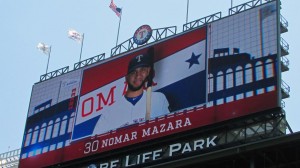
Rangers fans hope the young Dominican’s results match those of his 80s predecessors, including a similarly regarded outfielder named Sammy Sosa. They’d probably also be happy with a career matching that of Rusty Greer, whose name Nadel brought up. Greer never made a Baseball America Rangers Top 10 prospects list, much less a national one. Grieve noted that nobody in or out of the organization foresaw the 10th-round pick forging a career worthy of induction into the Rangers Hall of Fame.
Grieve also mentioned a pair of highly anticipated mid-80s outfielders who never quite matched their college production, Oddibe McDowell and Pete Incaviglia (whom the Rangers didn’t draft, but for whom they traded before he made his pro debut in the Major Leagues). The duo’s solid but not exceptional careers demonstrate that there is no sure thing when it comes to predicting players’ futures. An even better example might be that of the only other Rangers outfielder named a Baseball America Top 10 national prospect. Rubén Mateo placed ninth in 1999 and sixth in 2000. The Dominican Republic native broke camp with Texas in 2000 and was hitting .291 with a .786 OPS when he suffered a terrible leg injury in his 52nd game of that season. The five-tool hopeful would play only 40 more games for the Rangers and never realize the promise his hype might have indicated.
Mazara has played 63 games going into tonight’s game against the team to whom the Rangers traded Mateo, the Reds. He is hitting .291 with a .780 OPS.
Every player needs a little luck to succeed. For Mazara’s sake, and that of the Rangers, we’ll hope he avoids injury and becomes the next Rangers outfielder to remind us of Señor Octubre.
Rush Olson has spent two decades directing creative efforts for sports teams and broadcasters. He currently creates ad campaigns, television programs, and related creative projects for sports entities through Rush Olson Creative & Sports and FourNine Productions.
RushOlson.com
Linkedin.com/company/rush-olson-creative-&-sports
Facebook.com/RushOlsonCreativeandSports
We’ve known a lot about Texas Rangers outfielder Nomar Mazara since he became a rich man at the age of sixteen years old. The Rangers paid the Dominican millions to join their organization, and baseball’s prospect evaluation machine kicked into overdrive.
Mazara’s tools and his record signing bonus made him a buzz-worthy player, as had his rapid progression through the minor leagues. All of the prospect-rating services had him highly ranked headed into this year, and he has not disappointed since making his Major League debut in April.
The team’s minor league system has annually ranked among the game’s best the past few years. The organization has produced loads of touted prospects. Mazara has one unique quality that makes him stand out from other latter-day projected future stars: his position.
Homegrown infielders like Ian Kinsler, Mitch Moreland, and Rougned Odor have joined organizational pitchers like C.J. Wilson, Derek Holland, Tommy Hunter, and Martin Perez on recent postseason rosters.
Far fewer DIY Rangers from Mazara’s position group have starred in recent Octobers. The likes of Josh Hamilton, Shin-Soo Choo, Nelson Cruz, and David Murphy arrived via trades or free agency. The idea, then, that an outfielder the club signed and developed has become close to a can’t-miss prospect creates excitement – excitement like we haven’t seen since . . . since . . . how about Juan González and Rubén Sierra?
The Rangers have had only two players ranked as a Baseball America Top 50 outfield prospect since the rankings began in 1990. 1992’s number 40-ranked Terrell Lowery played 123 Major League games, none of them with Texas. The other one we’ll get to in a moment.
I discussed the Sierra/González comparisons with three long-time Rangers experts : broadcasters Steve Busby, Tom Grieve, and Eric Nadel. All agreed that the overall level of prospect hype has grown significantly since the mid-to-late 1980s when Sierra and González came of age. Grieve pointed out that we had no Newberg Report, no sports talk radio, and a much lower profile for the Baseball America publication.
In general, however, all three pointed out that when Sierra and González did arrive, it was with as much fanfare as the era could muster. Nadel remembered then-Rangers hitting coach Tom Robson pointing out Sierra’s five tools and calling him “the franchise.” That first Baseball America Top 100 list in 1990 had González ranked fourth in all of baseball, trailing top-ranked Steve Avery as well as Ben McDonald and Jon Olerud. More ratings services exist now, and Mazara’s highest slot has been a fifth place by Baseball Prospectus.
Mazara, then, is close to the Caballo/Igor level of prospect status (and after two consecutive A.L. Rookie of the Month awards, has pretty much moved from being designated a prospect to becoming a bona fide Major Leaguer). The difference, as Grieve sees it, is certainty. As the Rangers GM at the time, he had better information than anyone about players’ talent levels, and he noted that pretty much everyone knew that Sierra and Gonzalez would be stars. Their “future was more visible,” as Grieve put it, than Mazara’s at this point in their development cycles.
That doesn’t mean the broadcasters don’t envision a potential perennial All-Star future for Mazara. Both Nadel and Grieve suggested that his body reminded them of González. Busby praised Mazara’s calm demeanor and his makeup, citing a May 10 pinch-hit appearance in which Mazara patiently worked a walk one night after going 0-6. He thought Mazara might be a more disciplined hitter than either Sierra or González were at a young age. The panel of experts are all excited by Mazara’s power potential, his hit tool, and his arm – qualities they admired in Sierra and González as young players.

Rangers fans hope the young Dominican’s results match those of his 80s predecessors, including a similarly regarded outfielder named Sammy Sosa. They’d probably also be happy with a career matching that of Rusty Greer, whose name Nadel brought up. Greer never made a Baseball America Rangers Top 10 prospects list, much less a national one. Grieve noted that nobody in or out of the organization foresaw the 10th-round pick forging a career worthy of induction into the Rangers Hall of Fame.
Grieve also mentioned a pair of highly anticipated mid-80s outfielders who never quite matched their college production, Oddibe McDowell and Pete Incaviglia (whom the Rangers didn’t draft, but for whom they traded before he made his pro debut in the Major Leagues). The duo’s solid but not exceptional careers demonstrate that there is no sure thing when it comes to predicting players’ futures. An even better example might be that of the only other Rangers outfielder named a Baseball America Top 10 national prospect. Rubén Mateo placed ninth in 1999 and sixth in 2000. The Dominican Republic native broke camp with Texas in 2000 and was hitting .291 with a .786 OPS when he suffered a terrible leg injury in his 52nd game of that season. The five-tool hopeful would play only 40 more games for the Rangers and never realize the promise his hype might have indicated.
Mazara has played 63 games going into tonight’s game against the team to whom the Rangers traded Mateo, the Reds. He is hitting .291 with a .780 OPS.
Every player needs a little luck to succeed. For Mazara’s sake, and that of the Rangers, we’ll hope he avoids injury and becomes the next Rangers outfielder to remind us of Señor Octubre.
Rush Olson has spent two decades directing creative efforts for sports teams and broadcasters. He currently creates ad campaigns, television programs, and related creative projects for sports entities through Rush Olson Creative & Sports and FourNine Productions.
RushOlson.com
Linkedin.com/company/rush-olson-creative-&-sports
Facebook.com/RushOlsonCreativeandSports
Tuesday, June 14, 2016
Fighting the Finals
This post originally appeared at the Fort Worth Weekly's website. To view it there : http://www.fwweekly.com/2016/06/14/sports-rush-a-playoff-crowd-sort-of/
If the Cowboys played the Cleveland Browns in the Super Bowl at the same time a last-place Rangers team took on a first-place Oakland A’s squad, how big a crowd would the baseball game draw?
Yes, I realize it’s a preposterous scenario: the Browns in the Super Bowl.
This proposition occurred to me while walking past the “Free Draymond” shirts into the Oakland Alameda Coliseum yesterday to watch the Rangers play the Athletics. That same evening, the Oracle Arena next door hosted Game 5 of the NBA Finals, with the hometown Warriors having an opportunity to clinch their second consecutive championship against visitors from Cleveland. The games started one hour apart, with the Dubs tipping off first.
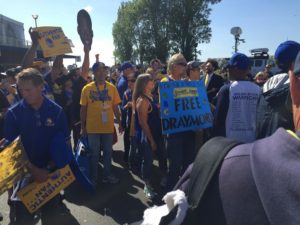
The two Oakland venues sit even closer to each other than Globe Life Park in Arlington and AT&T Stadium. They share parking lots and, until last season, long periods without championships (a distinction that unfortunately still applies to their Arlington counterparts). The Finals game sold out, as would a Super Bowl. But how did the A’s do attendance-wise?
I admit that I conceived this column with a bit of the stereotypical NASCAR approach: I wanted to see a wreck. See, the Green and Gold don’t draw well even without a North American championship match occurring next door. The perennially average in the bottom third of MLB, and the just over 18.5K they’ve averaged this season ranks in the bottom three. I imagined a crowd made up of the players’ families, the media, and Draymond Green.
They had pleasant weather for last night’s game, but that was about all it had going for it. Scheduled Rangers starter Yu Darvish might have drawn some walkup interest from local fans who followed him in Japan, but the Rangers put the righty on the disabled list just before the game with right shoulder discomfort. Darvish’s replacement César Ramos might have had some family drive up from his native SoCal to see his start, but apparently not quite enough Ramoses made the trip to fill the coliseum. It was probably for the best – he gave up six earned runs in 3 2/3 innings as Texas lost big.
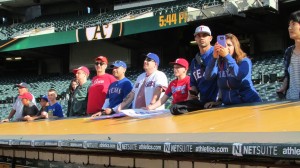
I kind of thought we had at least a chance to have more Rangers fans than A’s supporters, but the Oakland faithful proved me wrong, although a lot of them did wear Warriors garb. During batting practice, we heard a few gratuitous cheers break out from fans following the hoops on their smartphones. That subsided once the baseball game began, though, replaced in at least one instance by a loud, out-of-nowhere “Texas sucks!” exclamation.
So the crowd may not have been big, but those who did attend had some personality, confirming what has always appeared to be the case on TV. For instance, I didn’t wear anything to indicate I had come from Texas, but a young man who appeared to be an A’s gameday employee nonetheless felt compelled to tell me he thought America had gotten past discrimination because two special ed students, both named Bush, had managed to get elected president. I feel like I’m reasonably creative, but I couldn’t have made that incident up.
I also spotted a guy with a Dave Stewart jersey and a Rollie Fingers/Salvador Dalí mustache. Heck, as far as I know, it might have been Rollie Fingers.
The games happened on a Monday, which is a tough baseball draw even in the best of situations. The Rangers would fight the calendar, too, if the NFL played our mythical summer Super Bowl as a Monday Night Football game. The ballclub has never played at home the same Monday the Cowboys played at AT&T Stadium. The last time the MNF and MLB overlapped in North Texas, the then-2nd place Rangers drew 13,356 on September 15, 2008, their second-smallest crowd of that season, as the Cowboys sold out Irving’s Texas Stadium.
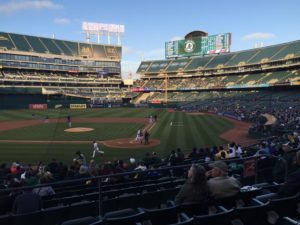

Yesterday, the A’s announced an attendance of 13,453. You can look at the photos and judge whether the stadium (capacity 35,067 in its normal baseball configuration without the upper deck) looks more than a third full. They’ve reported 11 crowds smaller than Monday’s this season. I wonder what those looked like.
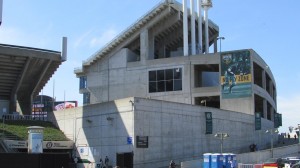
In fairness to the fans who stayed home or went next door, the team does play all the games in this particular stadium. It opened in 1966 and is the last remaining facility that still hosts both Major League Baseball and NFL football (at least until the Raiders move again). Tarps cover the upper decks to make the concrete monolith a sliver more intimate. I’ve kind of disliked the place since one of its denizens goaded one of my favorite players, Frank Francisco, into an ill-advised chair toss during a 2004 pennant race, but I actually didn’t hate it now that I’ve been here (not that there aren’t plenty of better stadia out there).
The fans who did come to Monday’s game had to pay $40 a carload to park, the inflated rate for an NBA Finals game. The A’s will make it up to any fans who return tonight by letting them park gratis, thanks to a Chevy Free Parking promotion.
The Warriors lost Monday, so if they don’t finish the series in Cleveland, the A’s will have to contend with Game 7 this Sunday when they host the Angels. Luckily for the baseballers, their contest that day starts seven hours earlier than the basketball game.
The Rangers have never drawn fewer than 26,131 against a same-day AT&T Stadium Cowboys game, that coming last September 13. That’s probably not an apples-to-apples comparison to how much a Cowboys playoff game might impact a baseball crowd, especially since the Rangers have mostly been a good team since the big spaceship opened. If they were lousy, all bets would be off.
Luckily, thanks to the way the schedules fall, they’ll never have to worry about it . . . although . . . given the Cowboys’ power to generate ratings, the networks might well be happy to look at moving the big game to June if it somehow made the Pokes more likely to play in it. If that happens, anything’s possible – even that the ‘Boys opponent might be the Browns.
Rush Olson has spent two decades directing creative efforts for sports teams and broadcasters. He currently creates ad campaigns, television programs, and related creative projects for sports entities through Rush Olson Creative & Sports and FourNine Productions.
RushOlson.com
Linkedin.com/company/rush-olson-creative-&-sports
Facebook.com/RushOlsonCreativeandSports
If the Cowboys played the Cleveland Browns in the Super Bowl at the same time a last-place Rangers team took on a first-place Oakland A’s squad, how big a crowd would the baseball game draw?
Yes, I realize it’s a preposterous scenario: the Browns in the Super Bowl.
This proposition occurred to me while walking past the “Free Draymond” shirts into the Oakland Alameda Coliseum yesterday to watch the Rangers play the Athletics. That same evening, the Oracle Arena next door hosted Game 5 of the NBA Finals, with the hometown Warriors having an opportunity to clinch their second consecutive championship against visitors from Cleveland. The games started one hour apart, with the Dubs tipping off first.

The two Oakland venues sit even closer to each other than Globe Life Park in Arlington and AT&T Stadium. They share parking lots and, until last season, long periods without championships (a distinction that unfortunately still applies to their Arlington counterparts). The Finals game sold out, as would a Super Bowl. But how did the A’s do attendance-wise?
I admit that I conceived this column with a bit of the stereotypical NASCAR approach: I wanted to see a wreck. See, the Green and Gold don’t draw well even without a North American championship match occurring next door. The perennially average in the bottom third of MLB, and the just over 18.5K they’ve averaged this season ranks in the bottom three. I imagined a crowd made up of the players’ families, the media, and Draymond Green.
They had pleasant weather for last night’s game, but that was about all it had going for it. Scheduled Rangers starter Yu Darvish might have drawn some walkup interest from local fans who followed him in Japan, but the Rangers put the righty on the disabled list just before the game with right shoulder discomfort. Darvish’s replacement César Ramos might have had some family drive up from his native SoCal to see his start, but apparently not quite enough Ramoses made the trip to fill the coliseum. It was probably for the best – he gave up six earned runs in 3 2/3 innings as Texas lost big.

I kind of thought we had at least a chance to have more Rangers fans than A’s supporters, but the Oakland faithful proved me wrong, although a lot of them did wear Warriors garb. During batting practice, we heard a few gratuitous cheers break out from fans following the hoops on their smartphones. That subsided once the baseball game began, though, replaced in at least one instance by a loud, out-of-nowhere “Texas sucks!” exclamation.
So the crowd may not have been big, but those who did attend had some personality, confirming what has always appeared to be the case on TV. For instance, I didn’t wear anything to indicate I had come from Texas, but a young man who appeared to be an A’s gameday employee nonetheless felt compelled to tell me he thought America had gotten past discrimination because two special ed students, both named Bush, had managed to get elected president. I feel like I’m reasonably creative, but I couldn’t have made that incident up.
I also spotted a guy with a Dave Stewart jersey and a Rollie Fingers/Salvador Dalí mustache. Heck, as far as I know, it might have been Rollie Fingers.
The games happened on a Monday, which is a tough baseball draw even in the best of situations. The Rangers would fight the calendar, too, if the NFL played our mythical summer Super Bowl as a Monday Night Football game. The ballclub has never played at home the same Monday the Cowboys played at AT&T Stadium. The last time the MNF and MLB overlapped in North Texas, the then-2nd place Rangers drew 13,356 on September 15, 2008, their second-smallest crowd of that season, as the Cowboys sold out Irving’s Texas Stadium.


Yesterday, the A’s announced an attendance of 13,453. You can look at the photos and judge whether the stadium (capacity 35,067 in its normal baseball configuration without the upper deck) looks more than a third full. They’ve reported 11 crowds smaller than Monday’s this season. I wonder what those looked like.

In fairness to the fans who stayed home or went next door, the team does play all the games in this particular stadium. It opened in 1966 and is the last remaining facility that still hosts both Major League Baseball and NFL football (at least until the Raiders move again). Tarps cover the upper decks to make the concrete monolith a sliver more intimate. I’ve kind of disliked the place since one of its denizens goaded one of my favorite players, Frank Francisco, into an ill-advised chair toss during a 2004 pennant race, but I actually didn’t hate it now that I’ve been here (not that there aren’t plenty of better stadia out there).
The fans who did come to Monday’s game had to pay $40 a carload to park, the inflated rate for an NBA Finals game. The A’s will make it up to any fans who return tonight by letting them park gratis, thanks to a Chevy Free Parking promotion.
The Warriors lost Monday, so if they don’t finish the series in Cleveland, the A’s will have to contend with Game 7 this Sunday when they host the Angels. Luckily for the baseballers, their contest that day starts seven hours earlier than the basketball game.
The Rangers have never drawn fewer than 26,131 against a same-day AT&T Stadium Cowboys game, that coming last September 13. That’s probably not an apples-to-apples comparison to how much a Cowboys playoff game might impact a baseball crowd, especially since the Rangers have mostly been a good team since the big spaceship opened. If they were lousy, all bets would be off.
Luckily, thanks to the way the schedules fall, they’ll never have to worry about it . . . although . . . given the Cowboys’ power to generate ratings, the networks might well be happy to look at moving the big game to June if it somehow made the Pokes more likely to play in it. If that happens, anything’s possible – even that the ‘Boys opponent might be the Browns.
Rush Olson has spent two decades directing creative efforts for sports teams and broadcasters. He currently creates ad campaigns, television programs, and related creative projects for sports entities through Rush Olson Creative & Sports and FourNine Productions.
RushOlson.com
Linkedin.com/company/rush-olson-creative-&-sports
Facebook.com/RushOlsonCreativeandSports
Sunday, June 12, 2016
5 Top Equestrian Events in Fort Worth This Summer
This post originally appeared on the website of the Fort Worth CVB. To read it there : http://www.fortworth.com/blog/post/2016/12/5-Top-Equestrian-Events-This-Summer-at-Will-Rogers/1267/
If you’ve ever heard
of Fort Worth, Texas, you’re aware of our cowboy
culture and the Fort
Worth Stock Show and Rodeo. You might even know they’ve held the Stock Show
at the Will
Rogers Memorial Center every year since 1944. But you may not realize the
complex hosts events year-round.
As you finalize your summer plans, you might
want to include a trip to see some skilled equestrians and outstanding equine
athletes. We checked in with David Reeves, Director of Sales for the Will
Rogers Memorial Center, to help us put together a list of five attractive dates
to add to your vacation calendar.
Mid-June brings a couple of events that showcase skills used by real-life ranch hands.
You’ll see remarkable horsemanship and teamwork at the Ranch Sorting National Championships World Finals June 13-18. Teams of riders sort cattle into their assigned pens with amazing precision.
They bill the All-Around Ranch Rodeo Challenge, held June 16-18, as the World's Richest Ranch Rodeo. It’s a chance for you to see teams from working ranches compete in tasks similar to those they use in their jobs as actual working cowboys and cowgirls. You can see them work with livestock at a frenetic pace in events like Wild Cow Milking, Branding, and Bronc Riding.

2. Appaloosa National Show and Youth World Championship: June 27 - July 9
This event will showcase a beautiful and versatile breed. The Appaloosa Horse Club will award some 130 National Championship titles and another 70 youth titles. You’ll have a lot of events to choose from - whether you value subtlety or speed, you can find it at this show.
David adds: “You’ll see some inspiring competitors at the Stars & Stripes Summer Spectacular on June 28 for equestrians with disabilities.”

3. American Paint Horse Association Youth World Championship: June 28 – July 9
In addition to naming youth world champions in each event, over $300,000 in scholarships and prizes will be awarded at the World Championships to young people who show and ride the American Paint Horses they love. David also recommends the ASHA Cowtown Ranch Classic on July 7 and the ACHA Cowtown Cutting on July 8-9, which are new additions this year.
You might have noticed that both the American Paint Horse and Appaloosa shows happen at the same time. Fort Worth is lucky enough to have a facility capable of accommodating more than one big show at once. Participants from both groups will appear in the Stars & Stripes Summer Spectacular, Youth Team Tournament, Youth Judging Contest, and the Cowtown Ranch Classic and Cowtown Cutting.

4. National Cutting Horse Association Summer Cutting Spectacular: July 16 - August 6
The final jewel of the NCHA's Triple Crown, this event will
attract some of the top competitors in the sport. Amateur cutters of
all ages get a chance to compete in their own contests, too.
David adds: "The Spectacular also includes the NCHA/Western Bloodstock Showdown and the NYCHA Youth World Finals."
5. Southwest Reined Cow Horse Rode to Reno: August 18-21
The SRCHA promotes training all breeds of horses in traditional ways. There’s a lot to see, including two NRCHA/ AQHA approved cow horse shows, a derby and futurity, and two AQHA ranch riding and reining competitions. The cowboys and cowgirls are trying to make it to the National Reined Cow Horse Association Snaffle Bit Futurity in Reno this September. And yep, they spell it “Rode.”
David adds:
"You will not want to miss the cow work portion of the cow horse show.
This is the most exciting element of the show and the basis for the
nickname, ‘The Greatest Show on Dirt'."
RushOlson.com
Linkedin.com/company/rush-olson-creative-&-sports
Facebook.com/RushOlsonCreativeandSports
Wednesday, June 8, 2016
Jeff Banister and Cat Osterman on Coaching Positively
This post originally appeared at the Fort Worth Weekly's website. To view it there : http://www.fwweekly.com/2016/06/07/sports-rush-jeff-banister-and-cat-osterman-discuss-coaching/
“Athletes want to know do you care about me And can you help me get to the next level? And that’s it. You care by developing a relationship.”
- Rangers manager Jeff Banister
Banister’s statement came as part of a program put on by a group called the Positive Coaching Alliance. Banister and softball icon Cat Osterman discussed the role coaches and other mentors play in making sports a positive experience for the players. This video explains what their talk was all about and passes along some of the insights they provided.
Banister won the American League Manager of the Year Award last season in his first year with the Rangers. Osterman won two Olympic medals along the way to becoming one of the best pitchers in softball history. She is now an assistant coach at Texas State University in San Marcos.
Rush Olson has spent two decades directing creative efforts for sports teams and broadcasters. He currently creates ad campaigns, television programs, and related creative projects for sports entities through Rush Olson Creative & Sports and FourNine Productions.
RushOlson.com
Linkedin.com/company/rush-olson-creative-&-sports
Facebook.com/RushOlsonCreativeandSports
“Athletes want to know do you care about me And can you help me get to the next level? And that’s it. You care by developing a relationship.”
- Rangers manager Jeff Banister
Banister’s statement came as part of a program put on by a group called the Positive Coaching Alliance. Banister and softball icon Cat Osterman discussed the role coaches and other mentors play in making sports a positive experience for the players. This video explains what their talk was all about and passes along some of the insights they provided.
Banister won the American League Manager of the Year Award last season in his first year with the Rangers. Osterman won two Olympic medals along the way to becoming one of the best pitchers in softball history. She is now an assistant coach at Texas State University in San Marcos.
Rush Olson has spent two decades directing creative efforts for sports teams and broadcasters. He currently creates ad campaigns, television programs, and related creative projects for sports entities through Rush Olson Creative & Sports and FourNine Productions.
RushOlson.com
Linkedin.com/company/rush-olson-creative-&-sports
Facebook.com/RushOlsonCreativeandSports
Subscribe to:
Posts (Atom)
